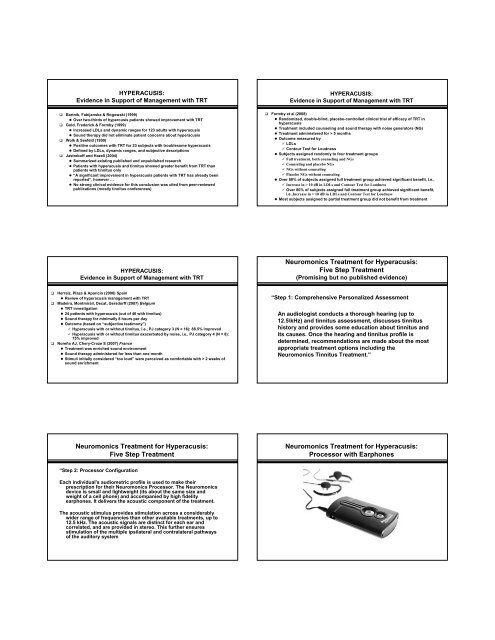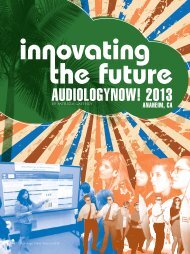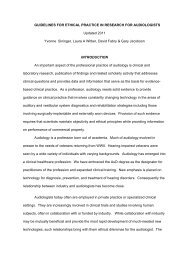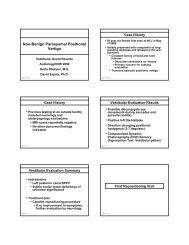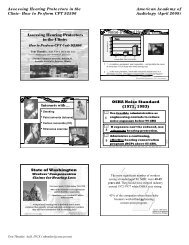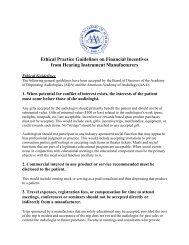HYPERACUSIS: ASSESSMENT AND MANAGEMENT
HYPERACUSIS: ASSESSMENT AND MANAGEMENT
HYPERACUSIS: ASSESSMENT AND MANAGEMENT
You also want an ePaper? Increase the reach of your titles
YUMPU automatically turns print PDFs into web optimized ePapers that Google loves.
<strong>HYPERACUSIS</strong>:<br />
Evidence in Support of Management with TRT<br />
� Bartnik, Fabijanska & Rogowski (1999)<br />
� Over two-thirds of hypercusis patients showed improvement with TRT<br />
� Gold, Frederick & Formby (1999)<br />
� Increased LDLs and dynamic ranges for 123 adults with hyperacusis<br />
� Sound therapy did not eliminate patient concerns about hyperacusis<br />
� Wolk & Seefeld (1999)<br />
� Positive outcomes with TRT for 23 subjects with troublesome hyperacusis<br />
� Defined by LDLs, dynamic ranges, and subjective descriptions<br />
� Jastreboff and Hazell (2004)<br />
� Summarized existing published and unpublished research<br />
� Patients with hyperacusis and tinnitus showed greater benefit from TRT than<br />
patients with tinnitus only<br />
� “A significant improvement in hyperacusis patients with TRT has already been<br />
reported”, however …<br />
� No strong clinical evidence for this conclusion was cited from peer-reviewed<br />
publications (mostly tinnitus conferences)<br />
<strong>HYPERACUSIS</strong>:<br />
Evidence in Support of Management with TRT<br />
� Herraiz, Plaza & Aparicio (2006) Spain<br />
� Review of hyperacusis management with TRT<br />
� Madeira, Montmirail, Decat, Gersdorff (2007) Belgium<br />
� TRT investigation<br />
� 24 patients with hyperacusis (out of 46 with tinnitus)<br />
� Sound therapy for minimally 8 hours per day<br />
� Outcome (based on “subjective testimony”)<br />
� Hyperacusis with or without tinnitus, i.e., PJ category 3 (N = 16): 88.5% improved<br />
� Hyperacusis with or without tinnitus exacerbated by noise, i.e., PJ category 4 (N = 8):<br />
75% improved<br />
� Noreña AJ, Chery-Croze S (2007) France<br />
� Treatment was enriched sound environment<br />
� Sound therapy administered for less than one month<br />
� Stimuli initially considered “too loud” were perceived as comfortable with > 2 weeks of<br />
sound enrichment<br />
Neuromonics Treatment for Hyperacusis:<br />
Five Step Treatment<br />
“Step 2: Processor Configuration<br />
Each individual's audiometric profile is used to make their<br />
prescription for their Neuromonics Processor. The Neuromonics<br />
device is small and lightweight (its about the same size and<br />
weight of a cell phone) and accompanied by high fidelity<br />
earphones. It delivers the acoustic component of the treatment.<br />
The acoustic stimulus provides stimulation across a considerably<br />
wider range of frequencies than other available treatments, up to<br />
12.5 kHz. The acoustic signals are distinct for each ear and<br />
correlated, and are provided in stereo. This further ensures<br />
stimulation of the multiple ipsilateral and contralateral pathways<br />
of the auditory system<br />
<strong>HYPERACUSIS</strong>:<br />
Evidence in Support of Management with TRT<br />
� Formby et al (2008)<br />
� Randomized, double-blind, placebo-controlled clinical trial of efficacy of TRT in<br />
hyperacusis<br />
� Treatment included counseling and sound therapy with noise generators (NG)<br />
� Treatment administered for > 5 months<br />
� Outcome measured by<br />
� LDLs<br />
� Contour Test for Loudness<br />
� Subjects assigned randomly to four treatment groups<br />
� Full treatment, both counseling and NGs<br />
� Counseling and placebo NGs<br />
� NGs without counseling<br />
� Placebo NGs without counseling.<br />
� Over 80% of subjects assigned full treatment group achieved significant benefit, I.e.,<br />
� Increase in > 10 dB in LDLs and Contour Test for Loudness<br />
� Over 80% of subjects assigned full treatment group achieved significant benefit,<br />
i.e.,Increase in > 10 dB in LDLs and Contour Test for Loudness<br />
� Most subjects assigned to partial treatment group did not benefit from treatment<br />
Neuromonics Treatment for Hyperacusis:<br />
Five Step Treatment<br />
(Promising but no published evidence)<br />
“Step 1: Comprehensive Personalized Assessment<br />
An audiologist conducts a thorough hearing (up to<br />
12.5\kHz) and tinnitus assessment, discusses tinnitus<br />
history and provides some education about tinnitus and<br />
its causes. Once the hearing and tinnitus profile is<br />
determined, recommendations are made about the most<br />
appropriate treatment options including the<br />
Neuromonics Tinnitus Treatment.”<br />
Neuromonics Treatment for Hyperacusis:<br />
Processor with Earphones


